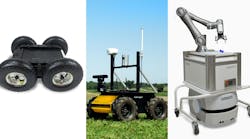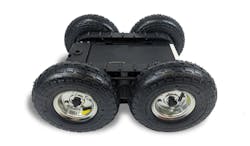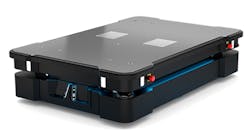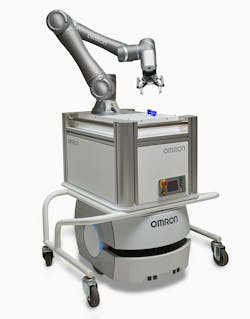Mobile Autonomous Robots
While companies such as Boston Robotic are producing videos of robots able to run, flip, or do chores around the house, we don’t see then doing these tasks in industry. Perhaps the biggest reason these humanoid robots aren’t common in industry is cost. Like most solutions, engineers want to find the simplest solution to a problem.
For example, if you need to transport a box of screws between two points and you have a person available, a kart could increase the amount of screws moved, reduce injury, and reduce worker fatigue. With the rising cost of labor and difficulty filling positions, eventually a company might need the kart to transport itself between points. While a walking robot could be advantageous, a couple LiDAR sensors with wheels, sensors, and programming might produce the same result at a much lower price point and reduce complexity.
Mobile Autonomous Robots
Getting things from point A to B can offer a lot of value. While self-driving vehicles have both value and hype around them, theey are already seeing use in factories. With perhaps more control of the environment, slower speeds, and other factors, companies such as Rover Robotics, MiR, Clearpath Robotics, and Omron are growing in manufacturing, warehouse, and other industries. The following are trends on where companies are finding value in these mobile robots, and some developments that might increase the adoption of this technology.
Dangerous and Hazardous Applications
There are a few major trends in mobile autonomous robots. One is that they are used in hazardous and dangerous situations and areas. RoboTex has produced robotics to keep law enforcement safe. Then, in 2018 the founder of Protolabs, a leader in rapid prototyping and low-volume manufacturing, and RoboTex used the Avatar lll law enforcement robot with a fully compatible open source Robot Operating System (ROS). The joint venture brought the robust design of law enforcement robots into a flexible manufacturing solution that is lightweight and cost-effective.
This four-wheel drive (4WD) rover has large tires so it can work well indoors or out. Watch for skirts or covering that limit ground clearance, or tires that might slip on inclines with heavy loads. This model can reach speeds up to 8 mph and can travel eight miles on a single charge. It can carry up to 60 lb (less than the 2WD rover because its skid steer). It’s fully compatible with ROS. Encoder data, battery state of charge, and motor temperature are all available using our ROS driver. Finally, it is so light a worker could pick it up.
One of the interesting facets of how Rover Robotics was able to maximize power and battery life while keeping weight down was that it offers a basic hardware platform so the design engineers can adjust, build, and program the robot for whatever application is needed on an open-source foundation. “90% of all mobile robots are ROS-based/open source and 100% of our robots are ROS-based open source. Users don’t like being locked into a vender,” says Rover Robotics Founder Nick Fragale. “Additionally, RoboTex already had many of the molds for parts and housings for injection molding. It might be easier and quicker to get to market with metal sheeting, but the added weight can really make a difference in performance.”
Before Rover Robotics, Clearpath Robotics, established in 2009 has produced autonomous mobile robots. Robots such as the Husky UGV can autonomously monitor construction sites or gather data for researchers in hazardous areas. Robots such as this are providing more data while promoting safety and cost savings associated with having people in the field. Additionally, large areas can be monitored with one robot, or less robots, than the multitude of sensors, batteries, and cables or wireless signals that would have to be placed manually around a site to gain similar data.
Mobile robots' ability to continuously roam autonomous can collect many data points over time to cover an area that might be too large for wireless sensors. Additionally, it is possible to have real-time video in some applications where a remote pilot could take over the machine to inspect an area, inventory, or see what resources are on location without leaving the office.
Resource Tracking and Allocation
Another robot from Clearpath is the TurtleBot 2. It might look like an autonomous driving shelving unit, but it is a good example of another large trend in mobile robots: resource tracking and allocation. Many autonomous robots in manufacturing keep production moving by ensuring feedstocks needed for the job are available. Having robots that can operate autonomously can eliminate downtime associated with the worker retrieving parts from inventory or waiting for someone else to restock parts.
Companies such as MiR are showing an increase in robots capable of transporting higher loads. Many mobile robotic companies produce a line of varying sizes and load capabilities. Overall, the trend of more weight and autonomous mobile robotics has been driving and producing robotic forklift solutions for years. With a range of solutions, sizes, and load capabilities, consider company growth and future demands to ensure the right tool is used for the right application.
MiR1000 is designed to automate and optimize the internal transportation of heavy duties and pallets. With a payload of 1000 kg, this is MiR’s most powerful robot, and even in highly dynamic environments it can transport heavy loads without any exterior safety measures.
Other things to consider might be software features. MiR and mobile robots like it can move resources around with real-time data. With additional technology it is possible to have a dynamic inventory that can changes based on needs. People might need to put the same product in the same place to remember everything’s location. With the right documentation software or tracking technology, mobile robots can move resources as needed to more efficient locations.
To maximize uptime or ensure that anytime a robot moves it has a purpose, it is possible to use an untasked or empty robot’s return trip to start relocating more in demand products closer to the loading docks or make shelf space for these products by taking less in demand products further from prime locations. This might be adding more complexity than necessary, but with increasing demand from industries such as E-commerce, this complexity should save time associated with logistics in shipping or production. Make sure technology isn’t needlessly complicated, but also, remember when looking for today’s solutions to consider potential future demands or problems.
Integration and Operation
Moving into the future some robotics engineers believe designers will be using open-source, user-friendly software and hardware to customize every robot. Currently there is a lot of attention on ROS. While it stands for robot operating system, it is more of an environment where users can upload and download programs.
Fragale of Rover Robotics uses ROS but believes the new ROS2 will take the mobile robot’s industry into the future. Currently, ROS lets companies upload free programs to a page where the community can alter or download programs directly into its robots. This means instead of buying a fully assembled, programmed, finished product, engineers can select a stripped down or basic platform, then add any other hardware for an application. One the mechanics and hardware are set up, designers will find an open-source program that will work for their solution. This might sound familiar to readers familiar with Arduino and Raspberry Pi because it is. In fact, there are many projects that use a program or software published on ROS with Arduino or Raspberry Pi hardware.
This demo was at PACK Expo 2019. Omron’s autonomous driving robot with its collaborative robot (cobot) is another trend. A cobot on an autonomous mobile robot adds extra value with abilities to load and unload resources, not to mention the possibility starting, stopping, loading, and unloading machines.
Currently, ROS might be a bit difficult or inundating for a non-programmer. However, Fragale mentions ROS2 could make customizing robotics possible for anyone. He sees a future were an engineer with no electronic or programming experience will be able access ROS and build custom robotics like an industrial Lego set. With Cloud analytics, solutions, and services it is also possible to streamline the whole project by selecting and setting up an Azure or AWS account with the new-found programming and hardware.
Some challenges in mobile robotics are no longer considered roadblocks. For example, mobile robots tend to have energy conservative electronics, lightweight materials, and are paired with software that manages energy consumption and recharging times that make powering mobile robots less of a challenge that it was previously. One challenge that will be important to pay attention to is computer analytics.
There can be a lot of hype around collecting all the data and sending it to advanced cloud spaces for processing. However, sending massive data—or just raw data—to the cloud builds latency and high cost into an operating system. “Rent Cloud space to send information not raw data,” says Fragale. “I tell clients all the time, run at the edge, train on the cloud.” It is possible to collect raw data, process it, respond to it, etc., all locally or on the Edge. Once a pattern emerges, N-value is reached, or the raw data is processed into information; it can hen be moved to the cloud. This reduces any latency and cost that can be associated with Cloud solutions, while still having the benefits.
Autonomous robots can add a lot of value to manufacturing and are able to be integrated and programmed quickly without a lot of experience. Based on the direction of the technology the future will continue to reduce cost while add more features. Additionally, robots will become easier to customize mechanical platform, its hardware, and the software. The use and ease of programming offered by cobots may see more adoption in these solutions especially as cameras advance with 3D vision and machine learning.





